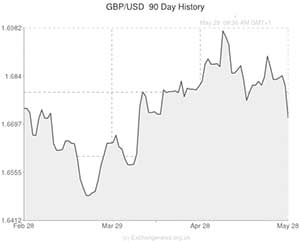
On Tuesday the Pound weakened against rivals like the Euro and US Dollar in response to a below-forecast UK mortgage approvals report.
As the overheating UK housing market has been one of the major arguments in favour of the Bank of England adjusting fiscal policy sooner rather than later, this sign of an easing in the sector caused Sterling to stumble.
The British asset extended declines against the US Dollar during the North American trading as the appeal of the ‘Greenback’ was enhanced by some surprisingly strong US data releases (including an unexpected increase in US durable goods orders).
On Wednesday the Pound’s moderately bearish relationship with the Euro continued in spite of the fact that unemployment in Germany rose unexpectedly.
A report showed that the level of unemployment in the Eurozone’s largest economy rose by almost 24,000 in May, rather than declining by the 15,000 expected.
The nation’s adjusted jobless rate held at an over twenty year low of 6.7 per cent.
Separate data showed that Germany’s import price index unexpectedly slumped by 0.3 per cent in April, month-on-month.
Despite these developments the Pound was still trading in the region of 1.2310 against the Euro as the local session progressed, down from a high of 1.2350.
The Euro was later buoyed by the news that measures of the Eurozone’s industrial and services confidence exceeded estimates in May and the region’s consumer confidence gauge came in at -7.1, as previously recorded.
The Pound also retained a 0.30 per cent decline against the Yen.
Although reports indicate that the Yen may be poised to reverse its recent run of gains, the Asian asset remains stronger against Sterling for the moment.
According to trading patterns, the Yen has been overbought and its failure to break free of its moving average against the US Dollar indicates that losses are on the horizon.
Currency strategist Joseph Capurso was recently quoted as saying; ‘The Yen is getting stretched. Japan’s probably got the weakest fundamentals, at least when it comes to how it affects the Yen. I think there’s more upside to Dollar-Yen and Euro-Yen, as well as Aussie-Yen.’
The expectation that the Bank of Japan will have little choice but to introduce additional stimulus at some point in the near future is also having an adverse impact on the safe-haven asset.
A lack of influential UK data restrained the Pound on Wednesday and helped its rivals retain the upper hand.
Today’s UK CBI reported sales figure for May could have a modest impact on the Pound, but in a light British news week global economic developments are likely to have a stronger impact on the currency.
British Pound Updated: 29/05/2014
It appears that the Pound’s impressive rally, which saw it achieve a 4 ½ year high against the US Dollar and a multi-month high against the Euro, is at an end.
In a comparatively quiet UK news week Sterling has tumbled against several of its major peers and is now in line to post its most notable four-week decline against the ‘Greenback’ for a year.
While the currency was boosted by expectations for a rate increase occurring before the spring of 2015, investors are reassessing their stance.
Despite the fact that Bank of England official Martin Weale recently stated that borrowing costs could climb by 1 per cent over a twelve month period, the Pound is seeing a reversal of gains.
Bloomberg quoted one industry expert as stating; ‘UK rate expectations seem to be anchored to a March rate hike. The hurdle is high for that being brought forward. We don’t see that much upside near term for Sterling. We’re not outright bearish but we don’t have it as a strong performer going forwards.’
As it stands Sterling is preparing to post a 1 per cent monthly drop against the US Dollar.
On Thursday the Pound did manage to recoup some of its losses against the ‘Greenback’ as US GDP data for the first quarter was negatively revised to contraction of 1.0 per cent – twice as much as the contraction of 0.5 per cent expected.
The Pound is also weaker against the Euro and trading close to a week low.
While this week has been very light in terms of UK data, tomorrow’s GfK consumer confidence index could impact Sterling.
The index is forecast to have risen from -3 to -2 in May.
Next week the Bank of England delivers its rate decision, so the Pound is likely to experience much more volatile trading.
Pound (GBP) Exchange Rates
[table width=”100%” colwidth=”50|50|50|50|50″ colalign=”left|left|left|left|left”]
Currency, ,Currency,Rate ,
Pound Sterling, ,US Dollar,1.6709,
,US Dollar,1.6709,
Pound Sterling, ,Euro,1.2290,
,Euro,1.2290,
Pound Sterling, ,Australian Dollar,1.8006,
,Australian Dollar,1.8006,
Pound Sterling, ,New Zealand Dollar,1.9753,
,New Zealand Dollar,1.9753,
US Dollar, ,Pound Sterling,0.5984,
,Pound Sterling,0.5984,
Euro, ,Pound Sterling,0.8137,
,Pound Sterling,0.8137,
Australian Dollar, ,Pound Sterling,0.5552,
,Pound Sterling,0.5552,
New Zealand Dollar, ,Pound Sterling,0.5071,
,Pound Sterling,0.5071,
[/table]

Comments are closed.